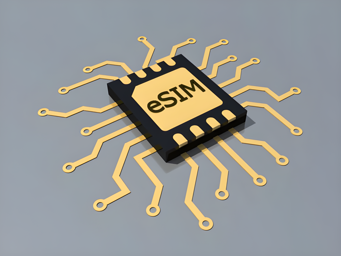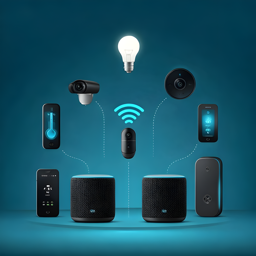LoRaWAN IoT Gateway: ESP32 and Raspberry Pi Setup Tutorial
Optimizing NB-IoT Handover & Cell Reselection on ESP32
Maintaining seamless connectivity in mobile NB-IoT Firmware Updates over NB-IoT: Delta Updates with ESP32’s Dual PartitionDiscover how delta firmware updates via NB-IoT optimize ESP32 device performance by minimizing data usage and ensuring secure, swift OTA transitions. deployments is critical, especially for applications like asset tracking, smart agriculture, and fleet management. This guide explores the mechanisms of network handovers and cell reselection in NB-IoT, their implementation on the ESP32 platform, and best practices
Firmware Updates over NB-IoT: Delta Updates with ESP32’s Dual PartitionDiscover how delta firmware updates via NB-IoT optimize ESP32 device performance by minimizing data usage and ensuring secure, swift OTA transitions. deployments is critical, especially for applications like asset tracking, smart agriculture, and fleet management. This guide explores the mechanisms of network handovers and cell reselection in NB-IoT, their implementation on the ESP32 platform, and best practices Zigbee Green Power: Ultra-Low-Power Energy Harvesting SolutionsDiscover how ZGP enables battery-free IoT devices through energy harvesting with ESP32 integrations, supporting smart home and industrial applications. for optimizing reliability, power efficiency, and security.
Zigbee Green Power: Ultra-Low-Power Energy Harvesting SolutionsDiscover how ZGP enables battery-free IoT devices through energy harvesting with ESP32 integrations, supporting smart home and industrial applications. for optimizing reliability, power efficiency, and security.
Table of Contents🔗
- Understanding Handovers and Cell Reselection in NB-IoT
 Firmware Updates over NB-IoT: Delta Updates with ESP32’s Dual PartitionDiscover how delta firmware updates via NB-IoT optimize ESP32 device performance by minimizing data usage and ensuring secure, swift OTA transitions.
Firmware Updates over NB-IoT: Delta Updates with ESP32’s Dual PartitionDiscover how delta firmware updates via NB-IoT optimize ESP32 device performance by minimizing data usage and ensuring secure, swift OTA transitions. - How NB-IoT
 Firmware Updates over NB-IoT: Delta Updates with ESP32’s Dual PartitionDiscover how delta firmware updates via NB-IoT optimize ESP32 device performance by minimizing data usage and ensuring secure, swift OTA transitions. Handovers Work
Firmware Updates over NB-IoT: Delta Updates with ESP32’s Dual PartitionDiscover how delta firmware updates via NB-IoT optimize ESP32 device performance by minimizing data usage and ensuring secure, swift OTA transitions. Handovers Work - Mechanisms of Cell Reselection in NB-IoT
 Firmware Updates over NB-IoT: Delta Updates with ESP32’s Dual PartitionDiscover how delta firmware updates via NB-IoT optimize ESP32 device performance by minimizing data usage and ensuring secure, swift OTA transitions.
Firmware Updates over NB-IoT: Delta Updates with ESP32’s Dual PartitionDiscover how delta firmware updates via NB-IoT optimize ESP32 device performance by minimizing data usage and ensuring secure, swift OTA transitions. - ESP32
 Setting Up ESP32 as a Wi-Fi Access PointMaster ESP32 AP configuration with our step-by-step guide. Set up a secure, local IoT network using practical code examples and optimization tips. Implementation: Configuring Network Transition Parameters
Setting Up ESP32 as a Wi-Fi Access PointMaster ESP32 AP configuration with our step-by-step guide. Set up a secure, local IoT network using practical code examples and optimization tips. Implementation: Configuring Network Transition Parameters - Real-World Scenarios: Asset Tracking and Mobile Sensors
- Handling Failed Handovers: Retry Strategies and Fallbacks
- Security Considerations
 Zigbee Over-the-Air (OTA) Firmware Updates with ESP32 CoordinatorsSecure your IoT network with OTA firmware upgrades using an ESP32 coordinator. Our guide details firmware setup, packaging, security, and troubleshooting. During Network Transitions
Zigbee Over-the-Air (OTA) Firmware Updates with ESP32 CoordinatorsSecure your IoT network with OTA firmware upgrades using an ESP32 coordinator. Our guide details firmware setup, packaging, security, and troubleshooting. During Network Transitions - Optimizing Power Consumption
 Quick Comparison: Range, power consumption, costs, and complexity of each technologyDiscover the ideal wireless solution for your ESP32 IoT project by analyzing range, power, cost, and complexity. Optimize connectivity now. During Cell Reselection
Quick Comparison: Range, power consumption, costs, and complexity of each technologyDiscover the ideal wireless solution for your ESP32 IoT project by analyzing range, power, cost, and complexity. Optimize connectivity now. During Cell Reselection - Testing and Simulation Tools
- Best Practices
 Zigbee Green Power: Ultra-Low-Power Energy Harvesting SolutionsDiscover how ZGP enables battery-free IoT devices through energy harvesting with ESP32 integrations, supporting smart home and industrial applications. for Industrial Deployments
Zigbee Green Power: Ultra-Low-Power Energy Harvesting SolutionsDiscover how ZGP enables battery-free IoT devices through energy harvesting with ESP32 integrations, supporting smart home and industrial applications. for Industrial Deployments
Understanding Handovers and Cell Reselection in NB-IoT🔗
NB-IoT devices Connecting ESP32 to Cloud Services via Wi-FiDiscover how to connect your ESP32 to AWS, Azure, and Google Cloud using secure Wi-Fi. This guide covers setup, error handling, and low power strategies., such as those based on the ESP32, experience two primary types of network transitions:
Connecting ESP32 to Cloud Services via Wi-FiDiscover how to connect your ESP32 to AWS, Azure, and Google Cloud using secure Wi-Fi. This guide covers setup, error handling, and low power strategies., such as those based on the ESP32, experience two primary types of network transitions:
1. Cell Reselection (Idle Mode):
- Occurs when the device is idle and selects a new cell with better signal quality
 SIM7000G Module with ESP32: Configuring LTE-M and GNSSMaster ESP32 integration with SIM7000G for reliable LTE-M connectivity and precise GPS tracking, featuring hardware setup, AT commands, and power tips..
SIM7000G Module with ESP32: Configuring LTE-M and GNSSMaster ESP32 integration with SIM7000G for reliable LTE-M connectivity and precise GPS tracking, featuring hardware setup, AT commands, and power tips.. - Governed by parameters like
NRSRP(Narrowband Reference Signal Received Power) andNRSRQ(Quality). - Example: A smart meter in a moving truck switches to a stronger cell to maintain coverage.
2. Handovers (Connected Mode):
- Network-controlled transition during active data transmission
 Connecting ESP32 to Cloud Services via Wi-FiDiscover how to connect your ESP32 to AWS, Azure, and Google Cloud using secure Wi-Fi. This guide covers setup, error handling, and low power strategies..
Connecting ESP32 to Cloud Services via Wi-FiDiscover how to connect your ESP32 to AWS, Azure, and Google Cloud using secure Wi-Fi. This guide covers setup, error handling, and low power strategies.. - Critical for real-time applications like asset tracking.
- Uses metrics like
RSRP,RSRQ, andSINR(Signal-to-Interference Zigbee Network Diagnostics: Resolving Packet Loss and InterferenceDiscover effective methods to diagnose and resolve packet loss and interference in Zigbee networks using ESP32, ensuring reliable IoT connectivity.-plus-Noise Ratio).
Zigbee Network Diagnostics: Resolving Packet Loss and InterferenceDiscover effective methods to diagnose and resolve packet loss and interference in Zigbee networks using ESP32, ensuring reliable IoT connectivity.-plus-Noise Ratio).
Key Differences:
| Metric | Cell Reselection (Idle) | Handover (Connected) |
|---|---|---|
| Trigger | Device-initiated | Network-controlled |
| Latency Impact | Low | High |
| Power Consumption | Moderate | High |
How NB-IoT Handovers Work🔗
Handovers in NB-IoT Firmware Updates over NB-IoT: Delta Updates with ESP32’s Dual PartitionDiscover how delta firmware updates via NB-IoT optimize ESP32 device performance by minimizing data usage and ensuring secure, swift OTA transitions. are managed collaboratively by the network and the device. Here’s how the process unfolds:
Firmware Updates over NB-IoT: Delta Updates with ESP32’s Dual PartitionDiscover how delta firmware updates via NB-IoT optimize ESP32 device performance by minimizing data usage and ensuring secure, swift OTA transitions. are managed collaboratively by the network and the device. Here’s how the process unfolds:
1. Measurement Reports: The device periodically measures the signal strength (RSRP/RSRQ) of neighboring cells and reports this data to the network.
2. Decision Making: The network evaluates the measurements and decides whether to initiate a handover to a neighboring cell with better signal quality SIM7000G Module with ESP32: Configuring LTE-M and GNSSMaster ESP32 integration with SIM7000G for reliable LTE-M connectivity and precise GPS tracking, featuring hardware setup, AT commands, and power tips..
SIM7000G Module with ESP32: Configuring LTE-M and GNSSMaster ESP32 integration with SIM7000G for reliable LTE-M connectivity and precise GPS tracking, featuring hardware setup, AT commands, and power tips..
3. Execution: The device disconnects from the current cell and reconnects to the target cell. This process introduces a small delay but is generally seamless.
Key Considerations:
- Handovers are less frequent in NB-IoT
 Firmware Updates over NB-IoT: Delta Updates with ESP32’s Dual PartitionDiscover how delta firmware updates via NB-IoT optimize ESP32 device performance by minimizing data usage and ensuring secure, swift OTA transitions. compared to LTE due to its focus on stationary or low-mobility devices.
Firmware Updates over NB-IoT: Delta Updates with ESP32’s Dual PartitionDiscover how delta firmware updates via NB-IoT optimize ESP32 device performance by minimizing data usage and ensuring secure, swift OTA transitions. compared to LTE due to its focus on stationary or low-mobility devices. - Handovers are more likely in urban environments with dense cell coverage.
Mechanisms of Cell Reselection in NB-IoT🔗
Cell reselection occurs when an NB-IoT Firmware Updates over NB-IoT: Delta Updates with ESP32’s Dual PartitionDiscover how delta firmware updates via NB-IoT optimize ESP32 device performance by minimizing data usage and ensuring secure, swift OTA transitions. device in idle mode selects the best cell to camp on. This process is governed by parameters like:
Firmware Updates over NB-IoT: Delta Updates with ESP32’s Dual PartitionDiscover how delta firmware updates via NB-IoT optimize ESP32 device performance by minimizing data usage and ensuring secure, swift OTA transitions. device in idle mode selects the best cell to camp on. This process is governed by parameters like:
- Cell Ranking: Based on signal strength (RSRP) and cell priority.
- Hysteresis: Prevents frequent switching between cells with similar signal strengths.
- Reselection Timers: Ensures stability by delaying reselection until conditions are stable.
Example Scenario:
A device camping on Cell A detects that Cell B has a stronger signal. After evaluating reselection criteria (e.g., hysteresis and timers), it switches to Cell B.
ESP32 Implementation: Configuring Network Transition Parameters🔗
When using Quectel BC66 Using Quectel BC66/BG96 Modules with ESP32 for NB-IoT ConnectivityExplore our detailed tutorial on integrating Quectel BC66/BG96 with ESP32 for low-power, reliable NB-IoT connectivity. Learn hardware setup and AT commands./BG96 modules with the ESP32, you can configure network transition parameters using AT commands:
Using Quectel BC66/BG96 Modules with ESP32 for NB-IoT ConnectivityExplore our detailed tutorial on integrating Quectel BC66/BG96 with ESP32 for low-power, reliable NB-IoT connectivity. Learn hardware setup and AT commands./BG96 modules with the ESP32, you can configure network transition parameters using AT commands:
// Set cell reselection hysteresis to 2dB (avoids ping-pong transitions)
AT+QCFG="nbsibscramble",1
AT+QCFG="reselectionhyst",2
// Enable handover reporting for real-time monitoring
AT+QINDCFG="ncellmeas",1
// Read neighboring cell info
AT+QENG="neighbourcell"
Output:
+QENG: "neighbourcell",<cell_id>,<rsrp>,<rsrq>,<sinr>
- Practical Tip: Use
AT+QENG="servingcell"to monitor current cell metrics and predict transitions.
Real-World Scenarios: Asset Tracking and Mobile Sensors🔗
Case 1: Fleet Tracking
An ESP32 Setting Up ESP32 as a Wi-Fi Access PointMaster ESP32 AP configuration with our step-by-step guide. Set up a secure, local IoT network using practical code examples and optimization tips.-based tracker on a delivery truck must handle frequent handovers. Implement buffering to prevent data loss during transitions:
Setting Up ESP32 as a Wi-Fi Access PointMaster ESP32 AP configuration with our step-by-step guide. Set up a secure, local IoT network using practical code examples and optimization tips.-based tracker on a delivery truck must handle frequent handovers. Implement buffering to prevent data loss during transitions:
void handover_callback() {
// Buffer GPS data during handover
buffer_data(gps_data);
delay(200); // Allow 200ms for transition
resend_buffered_data();
}
Case 2: Smart Agriculture
Soil sensors on movable irrigation systems use cell reselection. Prioritize power-saving:
// Configure eDRX cycle to 10.24s during idle
AT+CEDRXS=1,4,"0100"
Handling Failed Handovers: Retry Strategies and Fallbacks🔗
1. Exponential Backoff:
int retry_delay = 1000; // Start with 1s
while (!handover_success) {
initiate_handover();
delay(retry_delay);
retry_delay *= 2; // Double delay each attempt
}
2. Fallback to Idle Mode:
If handovers fail repeatedly, force cell reselection:
AT+CFUN=0 // Disable RF
AT+CFUN=1 // Re-enable (triggers reselection)
Security Considerations During Network Transitions🔗
- Encrypt Context Transfer: Ensure security keys (KASME) are transferred securely during handovers.
- Validate Cell IDs: Reject connections to rogue cells by cross-referencing pre-approved cell IDs stored in ESP32’s
 Combining Wi-Fi with Deep Sleep for Low-Power ApplicationsLearn how to integrate Wi-Fi and deep sleep on ESP32 to maximize battery life in IoT devices. This guide offers practical tips and step-by-step instructions. NVS.
Combining Wi-Fi with Deep Sleep for Low-Power ApplicationsLearn how to integrate Wi-Fi and deep sleep on ESP32 to maximize battery life in IoT devices. This guide offers practical tips and step-by-step instructions. NVS. - Mitigate MITM Attacks:
// Verify PLMN (Public Land Mobile Network) ID
AT+COPS? // Check current operator
if (PLMN != expected_PLMN) { disconnect(); }
Optimizing Power Consumption During Cell Reselection🔗
- Adjust Measurement Intervals:
// Measure neighbor cells every 5s instead of 2s
AT+QCFG="ncellmeasinterval",5
- Disable Unnecessary Bands:
// Restrict to Band 8 (900MHz) if deploying in Europe
AT+QBAND=1,8
| Configuration | Current Draw | Battery Life (2000mAh) |
|---|---|---|
| Default (2s intervals) | 12mA | 7 days |
| Optimized (5s + Band 8) | 8mA | 10 days |
Testing and Simulation Tools🔗
1. Network Simulators:
- Use Keysight UXM5G to emulate NB-IoT
 Firmware Updates over NB-IoT: Delta Updates with ESP32’s Dual PartitionDiscover how delta firmware updates via NB-IoT optimize ESP32 device performance by minimizing data usage and ensuring secure, swift OTA transitions. cells with varying signal strengths.
Firmware Updates over NB-IoT: Delta Updates with ESP32’s Dual PartitionDiscover how delta firmware updates via NB-IoT optimize ESP32 device performance by minimizing data usage and ensuring secure, swift OTA transitions. cells with varying signal strengths.
2. Field Testing:
- Log
RSRP/RSRQwith ESP32’s Combining Wi-Fi with Deep Sleep for Low-Power ApplicationsLearn how to integrate Wi-Fi and deep sleep on ESP32 to maximize battery life in IoT devices. This guide offers practical tips and step-by-step instructions. SD card module during vehicle movements.
Combining Wi-Fi with Deep Sleep for Low-Power ApplicationsLearn how to integrate Wi-Fi and deep sleep on ESP32 to maximize battery life in IoT devices. This guide offers practical tips and step-by-step instructions. SD card module during vehicle movements.
3. Custom Signal Attenuators:
Simulate weak signals with programmable RF attenuators like Mini-Circuits RCDAT-8000.
Best Practices for Industrial Deployments🔗
1. Pre-configure Neighbor Cells:
Hardcode common cell IDs in ESP32 Setting Up ESP32 as a Wi-Fi Access PointMaster ESP32 AP configuration with our step-by-step guide. Set up a secure, local IoT network using practical code examples and optimization tips. firmware for faster reselection.
Setting Up ESP32 as a Wi-Fi Access PointMaster ESP32 AP configuration with our step-by-step guide. Set up a secure, local IoT network using practical code examples and optimization tips. firmware for faster reselection.
2. Prioritize Static Cells:
In hybrid (fixed/mobile) deployments, bias reselection toward stationary cells.
3. Monitor Transition Counts:
Trigger alerts if handovers exceed 10/hour (potential antenna issue).
- Final Thought: NB-IoT handovers and cell reselection are not just network concerns-they are firmware design challenges
 Zigbee Green Power: Ultra-Low-Power Energy Harvesting SolutionsDiscover how ZGP enables battery-free IoT devices through energy harvesting with ESP32 integrations, supporting smart home and industrial applications.. By tailoring ESP32’s interaction with cellular modules, you can achieve the 99.9% uptime demanded by industrial IoT, even in motion. Whether you're tracking assets or monitoring remote sensors, mastering these transitions is key to building robust NB-IoT solutions
Zigbee Green Power: Ultra-Low-Power Energy Harvesting SolutionsDiscover how ZGP enables battery-free IoT devices through energy harvesting with ESP32 integrations, supporting smart home and industrial applications.. By tailoring ESP32’s interaction with cellular modules, you can achieve the 99.9% uptime demanded by industrial IoT, even in motion. Whether you're tracking assets or monitoring remote sensors, mastering these transitions is key to building robust NB-IoT solutions Connecting ESP32 to Cloud Services via Wi-FiDiscover how to connect your ESP32 to AWS, Azure, and Google Cloud using secure Wi-Fi. This guide covers setup, error handling, and low power strategies..
Connecting ESP32 to Cloud Services via Wi-FiDiscover how to connect your ESP32 to AWS, Azure, and Google Cloud using secure Wi-Fi. This guide covers setup, error handling, and low power strategies..
This comprehensive guide combines theoretical insights with practical implementation strategies, ensuring that your ESP32-based NB-IoT Firmware Updates over NB-IoT: Delta Updates with ESP32’s Dual PartitionDiscover how delta firmware updates via NB-IoT optimize ESP32 device performance by minimizing data usage and ensuring secure, swift OTA transitions. deployments are optimized for reliability, security, and energy efficiency.
Firmware Updates over NB-IoT: Delta Updates with ESP32’s Dual PartitionDiscover how delta firmware updates via NB-IoT optimize ESP32 device performance by minimizing data usage and ensuring secure, swift OTA transitions. deployments are optimized for reliability, security, and energy efficiency.
Author: Marcelo V. Souza - Engenheiro de Sistemas e Entusiasta em IoT e Desenvolvimento de Software, com foco em inovação tecnológica.
References🔗
- Arduino IDE Official Website: arduino.cc
- ESP-IDF Programming Guide: docs.espressif.com/projects/esp-idf
- ESP32 Arduino Core Documentation: docs.espressif.com/projects/arduino-esp32
- ESP32 Arduino Core Repository: github.com/espressif/arduino-esp32
- Espressif Documentation: docs.espressif.com

 7 months ago
7 months ago
 7 months ago
7 months ago
 7 months ago
7 months ago
 7 months ago
7 months ago
 7 months ago
7 months ago
 7 months ago
7 months ago
 7 months ago
7 months ago
 7 months ago
7 months ago
 8 months ago
8 months ago
 7 months ago
7 months ago
 7 months ago
7 months ago
 7 months ago
7 months ago
 7 months ago
7 months ago
 7 months ago
7 months ago
 7 months ago
7 months ago
 7 months ago
7 months ago
 7 months ago
7 months ago
 7 months ago
7 months ago
 7 months ago
7 months ago
 7 months ago
7 months ago
 7 months ago
7 months ago
 7 months ago
7 months ago
 7 months ago
7 months ago